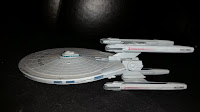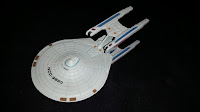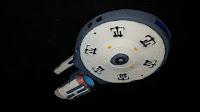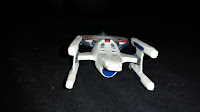This article is going to focus on the USS Stargazer. We first meet this class of starship in the Star Trek: The Next Generation episode titled, "The Battle".
As you can see, my current collection consists of an Eaglemoss, a Furuta and a MicroMachine model. I also purchased a Cozmo Heavy Industries model which I built, painted and wrote a review on.
Per Memory Alpha and Beta, "The Constellation-class starship was a type of Federation star cruiser employed by Starfleet from the late 23rd century through the late 24th century. The Constellation-class began service as early as 2285, when at least one such ship, the USS Hathaway, was constructed by Yoyodyne Propulsion Systems at the Copernicus Ship Yards on Luna. Nearly a decade after the launch of the Hathaway, the prototype for the class, the USS Constellation, was still undergoing certification trials. During the early 24th century, the Constellation-class was noted for performing both deep-space exploration and defensive-patrol duties." They go on to say this about the USS Stargazer (NCC-2893), "The USS Stargazer (NCC-2893 or NCC-7100) was a Constellation-class cruiser. The vessel was commanded by Jean-Luc Picard from 2333 to 2355. Stargazer was a participant in the Battle of Maxia Zeta in 2355. Daimon Bok returned the starship to the Federation in 2364."
If you would like to read more official stuff on this type of ship, feel free to check out the following links:
Constellation Class Information: Memory Alpha LINK and Memory Beta LINK
USS Stargazer (NCC-2893) Information: Memory Alpha LINK and Memory Beta LINK
Let us take a real quick look at the MicroMachine model. I don't usually dwell on these tiny models as they fall outside my normal collecting tastes, however, this one has interesting side story to it.
Eaglemoss vs. Furuta (vs. Cozmo Heavy Industries)
Normally, I would not include a model that I built, but since it is 1:2500 in scale, I felt that it would give a better idea of the sizes of the other models. As you can see, the Eaglemoss ship is much larger than the Furuta model. There are some subtle differences between the two, making each unique and good in thier own way.
Eaglemoss
I'm going to break with my traditional approach to talking about the models.
I love the fact that Eaglemoss decided to tackle this ship and give us thier rendition of it. HOWEVER, the most glaring issue that immediately stood out for me, involved the saucer section.
Filming Model As Seen In Episode
Photo Credit: Memory Alpha
Eaglemoss claims that thier models are the most screen accurate. The magazine goes into detail about how the filming model was made. This involved, gluing two top halves of Constitution class refit saucer sections together. Every model I have ever seen, every picture I have ever seen of this ship, shows the saucer section as being thicker than a Constitution or Miranda class ship.
Eaglemoss Model
Yet, Eaglemoss, even after stating that it was thicker in thier magazine, has given us a model with a thin saucer section. That's not very screen accurate.
I do confess that I read a couple of other bloggers' reviews and thier take on the Eaglemoss' models. I think that this allows me to get a feel for whether I missed something, or to see if my model has something out of the ordinary.
That being said, I don't feel alone when I bring up this next issue. It seems like the nacelles are not squared off with the saucer section when you look at it from the front.
This model seems to be chock full of manufacturer issues too. One more common issue that was noticeable to me on my model, as well as to other reviewers, is that the seam around the saucer section is not very flush.
Now that I'm done bashing the flaws, let's talk about some very good things about Eaglemoss' model.
The sculpted and molded details on this model are fantastic. All the key pieces are represented.
The underside of the saucer section is great, especially with Eaglemoss' attempt at representing the various greebles the show's designers had put on their filming model.
Adding the protruding antenna on the one greeble was an extra nice touch.
The paint work on this model is really nice, at least it is nice in the places that it was applied. The entire saucer section has a very light aztec pattern applied to it. Unfortunately, the aztecing does not extend to the engineering section or the nacelles, which throws the entire look off balance.
While the top of the saucer is really well done when it comes to painted details, the bottom appears to be missing the RCS thrusters. I really wish that Eaglemoss had given the bridge module and the bottom sensor dome a little more love than just that blue ring around them.
And now, I have to lie, and actually make another major complaint. The engineering section completely is devoid of any painted details and this really detracts from the overall beauty of the model.
This lacking of details is really disappointing. I think that Eaglemoss should have forgone the aztec details and used that part of the paint budget to add a little color to the engineering section. Had they done this, I think that this model would have really stood out as a champion.
Anytime I review a Starfleet ship, I like to hyper-focus on the deflector dish as it usually gives me a good idea of the level of attention to details that a manufacturer puts into thier models. Let's face it, this is a very important part of the ship and should be accurately represented.
Unfortunately, the Constellation does not have a noticeable deflector dish, so this will be my first Starfleet vessel review to not have a close-up view of this part.
What I can focus on though is the photon torpedo launchers that are tucked away nicely underneath the nacelle struts.
While seeing the molded weapons in place, the lack of paint really screws up the look and they end up just sort of blending into the rest of the model.
If you look past the crooked nature of the nacelles, you will find that they are actually very nicely done as far as molding and painting goes. And the clear blue plastic for the grill work was a super cool touch.
I also love the fact the Eaglemoss managed to squeeze the Starfleet pennant onto the nacelles.
Looking back on this article so far, I know that it seems like I gave the Eaglemoss model a rather harsh review. Overall, I find it to be a good model, but this one was not executed well and can not be considered one of Eaglemoss' better designs.
Furuta
I always like to point the following out for my first time readers. Furuta is a Japanese company that produced a series of gashapon toys. Gashapon toys are meant to be nothing more than cheap little $1 to $5 bubble gum machine prizes. I like to remind my readers of this fact so that they can take any critical reviews I may make in the spirit it is given. I am in no way expecting these toys to be on the level of a Hallmark, Eaglemoss or Hot wheels toy. I found a neat video about these types of toys and you can check that out at THIS LINK.
Overall, I am pretty happy with Furuta's attempt at making this ship. Considering that this was originally a cheap little toy, Furuta managed to accomplish a lot with thier model.
The thickness of the saucer section is appears to be comparrable to the screen used model.
Furuta did a great job with thier sculpted and molded details. I was especially impressed with thier handling of the bottom greebles and that antenna array.
The paint work is where Furuta loses some major points though.
The first, and most noticeable paint issue is the lack of detailed painting of the phaser banks. No Starfleet model should be missing these, period.
While the Furuta model's engineering section is a bit better that Eaglemoss when it comes to painting, there were some areas that could have used a little extra touches. Although they did paint a little detail to the impulse engine crystal, they could have taken it one step further and added a dash of red to the exhaust ports to finish this area off.
Given the fact that Furuta had a tight budget to work with when producing this ship, I suppose that we can forgive them for not including the photon torpedo launchers on the top and bottom.
The nacelles were handled nicely on the Furuta model. The molded details and painted details were well done.
And Furuta even attempted to make it look like there were Starfleet pennants. Sadly, the nacelles suffer from bowing outwards as you progress towards the rear of the ship.
Over all, I thought that Furuta gave us a pretty decent model of the ship.
Conclusion
And that is all the pictures and comparisons I have to share on this ship at this time. Which brings us to the pricing portion of my article. As usual, I will continue with the tradition of rounding up the most inexpensive Buy-It-Now prices from eBay at the time of this article's (re)writing (May 2018).
Eaglemoss = $28
Furuta = $34
Micro Machine = $12
NOTE: Prices were researched last on May 1st, 2018. As of the writing of this article, you can also currently order the Eaglemoss model right from the company themselves for around $23 (shipping unknown).
The Furuta model has become a bit of a more rare bird to get you hands on. the pricing seems to fluctuate. when I first wrote this article back in February 2015, she was going for around $44. During my last re-write, she was going for around $26 and now is back up again.
So here we are, at the part of my article where I tell you what I think would be the "Best Bang For The Buck". That's my crude way of saying, which one is the best buy.
And this is where the pricing of these models will really affect my decision. I like to try to recommend a good model that isn't going to break the bank. When I first wrote this article, the Furuta cost of $44 knocked it out of the running for my recommendation. The price drop in 2015 for the Furuta model had made that model a much more compelling recommendation.
HOWEVER, even with it being better priced, when you compare the ships side by side, you seem to be getting more for your money with the Eaglemoss model. And that is taking in consideration all the issues I mentioned earlier.
As long as you are willing to overlook the saucer thickness issue and the lack of painting details in certain areas, then you would best be served with the Eaglemoss model.
BONUS ROUND!!!
Every once in a while, I'll have a little extra stuff to share with you that sort of fits in with my comparison articles.
As I shared at the beginning of this article, I also own a Cozmo Heavy Industries resin kit of this ship.
USS Gettysburg (NCC-3890)
Constellation Class
1:2500 Cozmo Heavy Industries Kit
Normally I would not have bought this kit. I typically only build models to fill gaps in my collection with ships that I can't buy in an already built and painted state, like Eaglemoss, Hallmark and Hot Wheels. I follow Jay, who owns and operates C.H.I. over at his FaceBook page and was entertained by his buildup of this ship. So, I figured I'd give it a go.
I was rather impressed with the kit and wrote an extensive review of it. Rather than repeat all of that material here, you really should go check it out at THIS LINK.
USS Contender (NCC-2604)
Challenger Class (Non-Cannon)
Challenger Class (Non-Cannon)
1:2500 Resin Modeler kit
From the reading I've done on this ship, it appears that it served as a prototype design for the Constellation Class (USS Stargazer) that Captain Picard first served on as captain. For all intent and purposes, this ship is pretty much is a science vessel.
The model maker labeled the ship as a Contender class, but I ended up renaming the classification for this ship to Challenger Class (Non-Cannon). While I was researching the ship for an upcoming review of the resin kit, I found some additional information about the vessel that supported my decision. She appears in some of The Next Generation comic books.
Once again, I actually have a review that I wrote up about this kit. Rather than repeat all of that material here, you really should go check it out at THIS LINK.
USS Kuklinski (MSD-5115)
Vogon Class Heavy Construction Vessel
1:2500 Cozmo Heavy Industries kitbash
Inspired by Jean-Paul Jesstiece
I was inspired to build this model after seeing someone else's attempt at building a ship used in construction. I decided to build my own starship and used quite a few Constellation Class parts in the build, so I decided to share that ship here.
The entire bottom half of the secondary hull is accessed via large hanger doors that open up to allow large items to be loaded into the cargo bay, much in the same way a 20th century Airbus Beluga can open up to accommodate bodies of other airplanes.
I have written up an entire article about this model, and once again, rather than rehashing the same material here, you can simply go to THIS LINK to read up on that ship.
As always, I hope you found this article useful and informative. If you have any questions, comments or suggestions, please feel free to comment below.
So for now, "Live long and prosper!!!"
Additional Links To Photos Of My Collection:
Eaglemoss Furuta
MicroMachine Comparative Shots
Other Reviewers Take On The Eaglemoss Model:
Some Kind Of Star Trek
Star Trek Starship Collection
MicroMachine Comparative Shots
Other Reviewers Take On The Eaglemoss Model:
Some Kind Of Star Trek
Star Trek Starship Collection













































































No comments:
Post a Comment